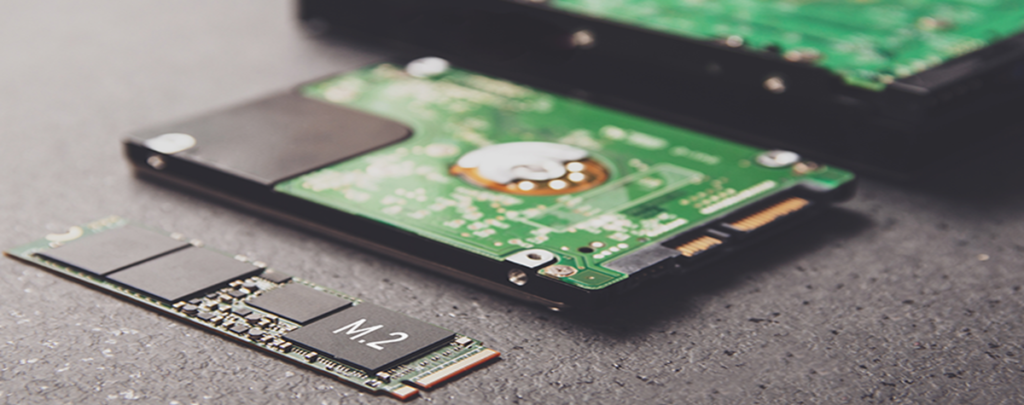The meteoric increase in the amount of data constantly promotes the emergence of new ideas in storage media. In 1956, IBM released a first hard disk drive (Hard Drive Disk, abbreviated HDD) on a magnetic basis. Its storage capacity of 5 MB then requires a mechanical support weighing 500 kilograms (!). In 1980, Seagate launched a 6MB HDD in a 5.25-inch technique on the market. Its price: 1000 dollars. Only 11 years later released the first 2.5-inch hard drive with a capacity of 100 MB. At the same time, the first Solid State Drives (SSD) with flash memory became interesting for practical use. Since then, SSDs have dethroned HDDs in many areas. Still, the classic hard drive has not had its last word. Read my article to find out when using an HDD is recommended and what makes it different from SDD.
SSD vs HDD: which operation for which technology?
An HDD differs from an SSD by its rotating magnetic disks, divided into tracks and zones. This hard disk has a read / write head, which moves on the rotating magnetic disk. The information to be stored is written onto the disc by magnetization. The different polarized sections are read back by the read / write head.
To simplify, the reading process is similar to playing a vinyl on a turntable: when a title is selected on the index (the cover of the disc), the reading head (the diamond) is placed in the ‘identifiable space between two titles (the groove) on the disc, then detects the data (here, the music). If you want to listen to another song, you have to start from scratch. On the HDD, an interface and a standardized socket ensure communication with the computer system. The internal HDD controller moves the read / write head to the requested section on the polarized storage tray. The data remains written on the HDD’s magnetic platter even when the HDD is turned off.
Unlike the SSD, the architecture of the HDD requires high precision mechanics. The magnetic storage tray is placed in a precise position, driven by an electric motor to perform a defined number of rotations, ranging from 5,400 to 15,000 revolutions per minute (the latter value applies to high performance computers and servers). The read / write head is actuated by a separate driving force and then lowered to the desired position. This too requires great precision, as the data tracks on the platter are barely 75 nanometers wide. The head “floats” in the air current caused by the rotation, 25 nanometers above the magnetic plate. For comparison, a human hair is 300 nanometers in diameter. If the read / write head and disk touch each other, it is the dreaded head landing that results in data loss.
HDD and SSD present a significant difference: the SSD no longer has any moving mechanical parts, or rotating magnetic plate, or read / write head. The data is stored on semiconductor cells. To achieve this, the system relies on the properties of a semiconductor (solid state), capable of maintaining an established charging (i.e. recording) status at any given time. The distribution of the information to be recorded over several million semiconductor cells is ensured by a controller, which “stacks” the data under certain conditions and, if necessary, or in the event of a potentially defective cell, moves the data. The absence of electrically actuated parts also allows the SSD to stand out from the HDD by its lower power consumption. In addition, it is also lighter and more compact.
SSD vs HDD: lifespan
With so many technical differences between HDD and SSD, it’s worth taking a look at the lifespan of these storage technologies. Mechanical solutions are now very successful, but will always end up wearing out naturally, especially because of friction (otherwise, we would reach perpetual motion). Thus, a typical hard drive has a lifespan of about five to ten years. This value may decrease further depending on the heat and mechanical load to which the storage medium is exposed. Some HDD manufacturers promise a lifespan of up to a million hours (or about 114 years). There are various diagnostic software that can be used to read the “state of health” of a hard drive. Defragmenting an HDD on a regular basis clearly extends its lifespan.
Unlike the HDD, the SSD is distinguished by a lifespan generally indicated by the volume of total writable data. The name consecrated in English is “Total Bytes Written” (abbreviated as TBW). For example, a home SSD with a capacity of 240 gigabytes is sold by its manufacturer with a three-year warranty for a total data volume of 72 terabytes. By calculating, we thus obtain an average of 65 gigabytes per day. A typical workstation registers between 20 and 30 gigabytes per day. Under these conditions, the SSD in our example should last about ten years. If working with large video or graphics files, the total data volume will be reached faster.
Industrial SSDs currently achieve up to five million write cycles, and the trend is increasing. So, for example, servers with SSDs are the solution of choice for forward-looking storage technologies, because they reduce both the energy consumption of server centers and their ecological footprint.













